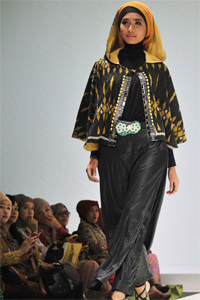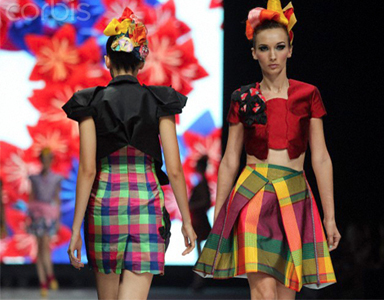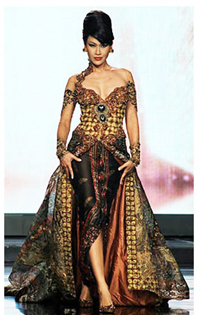Increasing Asian wealth, ethnic influences and Islamic design to impact upon global styling
Op-Ed Commentary: Chris Devonshire-Ellis

Funky Indonesian Chic by Anne Avantie
With the Indonesia Fashion Week just finished, it is becoming apparent that Jakarta and Indonesian fashion designers are stealing a march upon their Asian rivals for claiming a stake to be Asia’s Haute Couture capital. It is a development that our firm, Dezan Shira & Associates, watches with keen eyes – we handle a lot of international high-end brands in Asia, including some of the world’s biggest and best known luxury names. Yet with some spectacular shows, the Indonesia Fashion week event is rapidly making its name as a “must do” on the international circuit, with international designers from as far away as Brazil, Argentina, and Morocco all appearing amidst a plethora of up-and-coming Indonesian designers.
I believe there are a number of factors that contribute to the success of the Indonesian event. Firstly, Asia as a region is developing as one of the world’s great consumer markets – over 525 million middle class consumers exist today, a figure expected to rise to 3 billion in the next twenty years. That signifies a change in tastes and style – much of Asia is warm, and a more relaxed styling attitude towards both business and designer wear is emerging. Going out are the stuffy suits and four-in-hand ties in sweltering Asian summers, instead the more relaxed, tie-less look is in. It is likely to stay. As is increasing opulence and a desire to be stylish – increasingly wealthy societies like to look good.
Coupled with the rise in Asian consumers now demanding to have clothes they can relate to and feel comfortable in, is also the rise of Islamic fashion. For women, this means headscarves and often full body covering outfits. Yet misunderstood as Islam often is in the West, Indonesia, a tolerant Islamic society, is showing how Islamic culture and especially in clothing can be both respectful, in accordance with the Koran, and stylish. The development of sophisticated Islamic haute couture design is also arriving.

Contemporary and stylish Islamic haute couture by designer Irna Mutiara
Third, and especially prevalent in Indonesia, is the national pride in their design heritage, and an embracing of their multi-cultural roots. Indonesia is the world’s fourth largest country by population, and has a huge ethnic and even tribal diversity. Most commonly recognizable in the different batik designs, the Indonesians embrace their minorities’ culture in a way that China, especially in contrast, does not. The result is a huge, diverse and colourful history of design that contemporary Indonesian designers are able to fall back on and cherry pick as part of a much loved national heritage.
In China, minorities are viewed with amusement with those funny old costumes pointed out as a sign of backwardness rather than beauty. It is to China’s shame that its own national beauty has become debased in this manner. Indonesia embraces its traditional culture and modernises it in a manner that China does not.
Tellingly, this is a theme espoused upon by Chinese born Hebe Lin, now in Singapore with Burberry. “In my view, the development of fashion in Asia requires a stable societal background, with social openness and prosperity. The status of women in society is an issue, as is creativty. In China, for example, the exam-oriented education does limit the imagination of students.”
Indonesia, in contrast, has an open and tolerant society, albeit conservative, but crucially one in which, for example, the gay community is largely accepted. This is important for the arts as, traditionally, the gay community worldwide has always played a vibrant and creative role within cultural dynamics. This societal dynamic is again making Jakarta an Asian hub for creativity and design – while able to draw upon the nation’s vast array of traditional culture at the same time.

Traditional Batik patterns remodeled for chic day wear by Lenny Augustin
These mixed three pillars of regional cultural awareness, coupled with a desire to wear more natural and locally suitable fabrics and styles, are driving the fashion industry in Asia forward and will, in turn, begin to impact upon international haute couture styling. As Asian consumers become more wealthy, so will a desire to display regional influences in how the fashion-conscious present themselves.
That move towards increasing wealth is where Asian design tends to meet the upmarket West – in a combination of regional flair and Western themed opulence. Several Indonesian designers have been mixing and matching Asian patterns and fabrics and reconstructing them into Western glamor – it is evident how much an impact the rise of Asian wealth is having on the top of the range designers.

Indonesia Kebaya remodelled for an evening dress by Anne Avantie
It is this combination of Asian style – much of the casual wear fit for both showing off on the beach or urban chic, with slightly more Westernised cutting used for office and smarter wear, yet still using traditional patterns and batiks – that makes the Jakarta appeal so vibrant. This, as mentioned when naturally mixed with the more conservative, yet still elegant Islamic wear and the mixing with traditional Kebaya with Western glamor makes for a heady and inspiring cocktail of ethnic, yet modern, shapes and form.
Supported by the Government, and with primary sponsors such as Garuda, the stage is set for Indonesian designers to take the international haute couture world by storm, and inject a healthy and colorful dose of Asian chic onto the runways in Milan, Paris and London. To some extent, this is already happening – the “new” Kate Moss and one of the hottest models today is Indonesian Charlotte Carey – hugely in demand and already a super-model in her own right. Asian haute couture is coming to the world, and Jakarta is right at the center of this new movement.
Selected Designer Highlights from Indonesia Fashion Week 2014
Chris Devonshire-Ellis is the Founding Partner of Dezan Shira & Associates – a specialist foreign direct investment practice providing corporate establishment, business advisory, tax advisory and compliance, accounting, payroll, due diligence and financial review services to multinationals investing in emerging Asia. Since its establishment in 1992, the firm has grown into one of Asia’s most versatile full-service consultancies with operational offices across China, Hong Kong, India, Singapore and Vietnam in addition to alliances in Indonesia, Malaysia, Philippines and Thailand as well as liaison offices in Italy and the United States.
For further details or to contact the firm, please email asia@dezshira.com, visit www.dezshira.com, or download the company brochure.
You can stay up to date with the latest business and investment trends across Asia by subscribing to Asia Briefing’s complimentary update service featuring news, commentary, guides, and multimedia resources.


